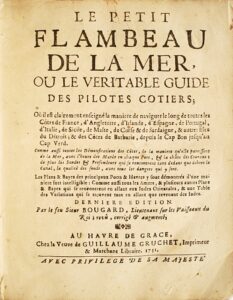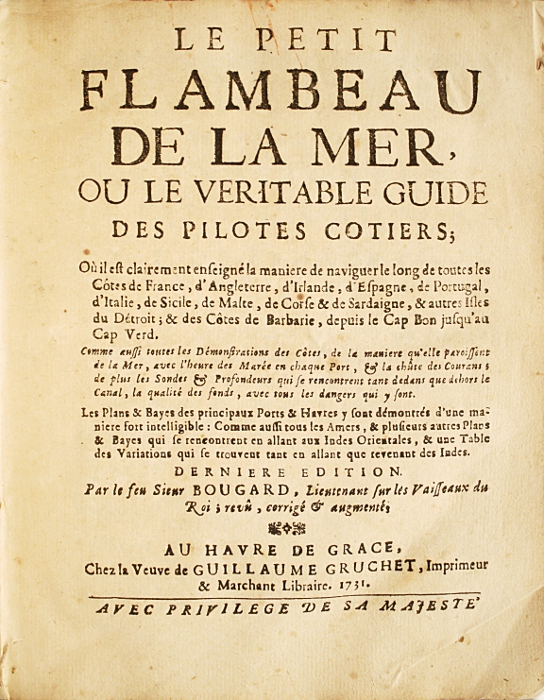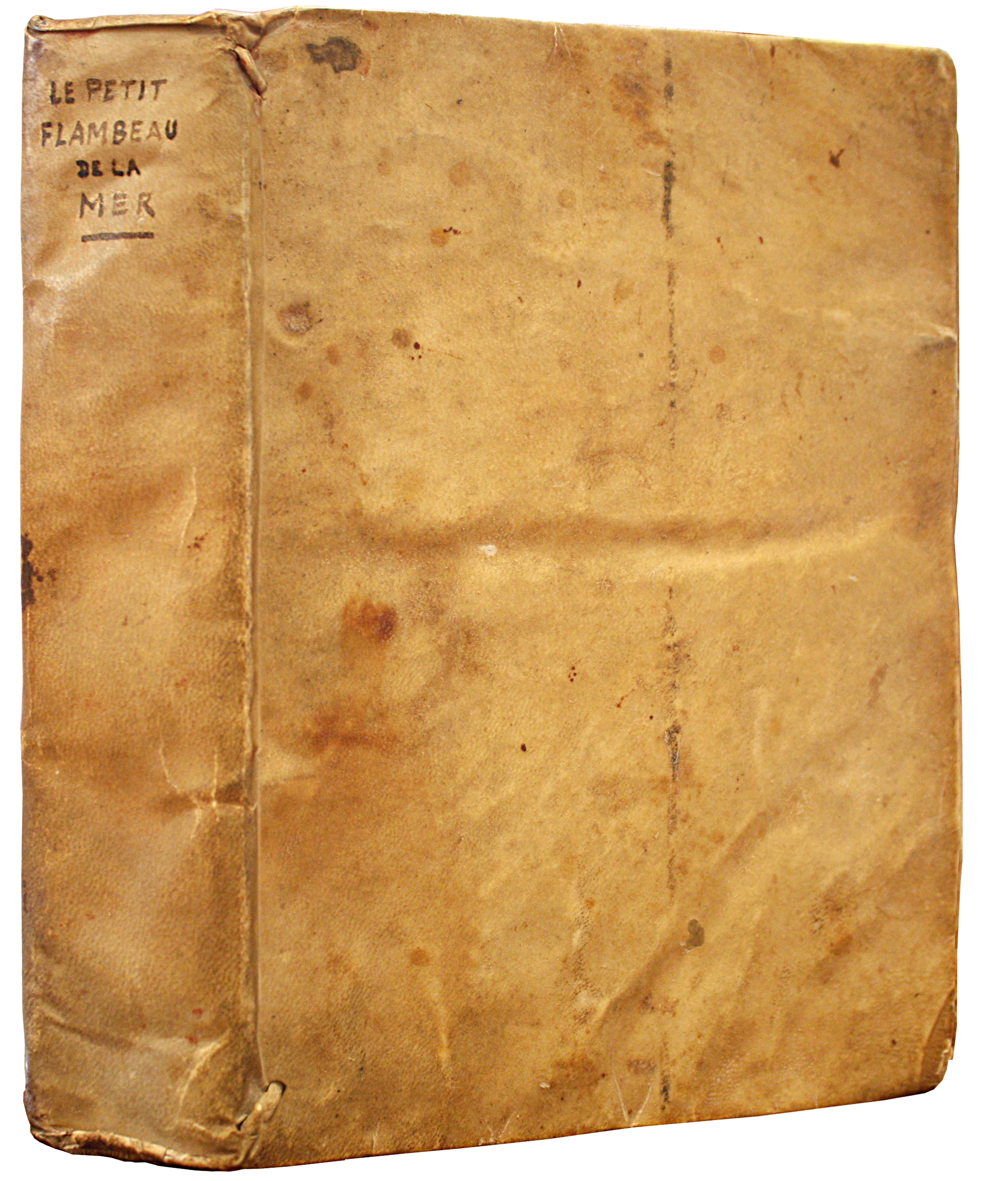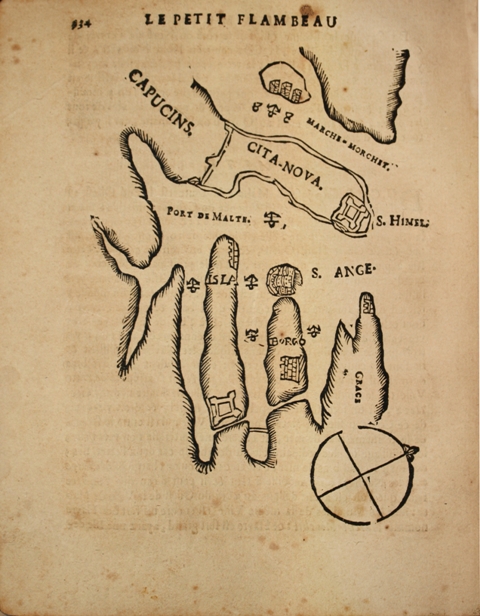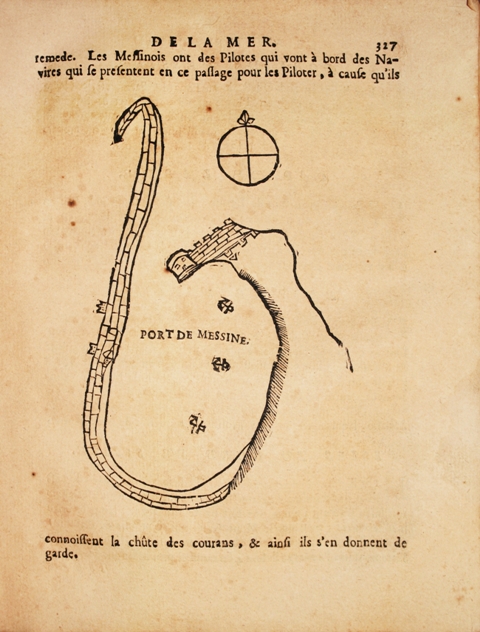Au Havre de Grace, chez la veuve de Guillaume Gruchet, 1731.
4to [178 x 140 mm] of (4) ll., 413 pp., bifolio signed “Entre C D” added between quires C and D, 23 pp., numerous maps and engravings in the text. Some foxing, manuscript marginalia on the endpapers. Bound in contemporary limp vellum, handwritten title on the flat spine, slightly soiled. Contemporary binding.
Fine edition of “the most famous marine pilot guide from the end of the 17th century”. (A. Charon, Le livre maritime au siècle des Lumières, pp. 135-136).
Frère, Manuel du bibliographe normand, 134 ; Quérard only mentions this edition. (I, p.447). «‘Le Petit Flambeau de la mer’ written by the Norman R. Bougard master of vessel in Le Havre, lieutenant of the King, was the most famous marine pilot guide from the end of the 17th century. ‘Le Petit Flambeau de la mer’ was published several times without any changes: twelve times in Le Havre between 1684 and 1789, twice in Saint-Malo in 1785 and 1817 as well as an English translation with maps added in 1801. In spite of its title referring to the great Dutch atlases, this work was more a cabotage handbook containing descriptions of coasts and brief instructions to enter into harbors… This work was mostly used as a manual of instruction in schools of Hydrography; that explains the numerous editions. In ‘Le Petit flambeau’, Bougard describes the coasts of France, England, Ireland, Spain, Portugal and all the Mediterranean coasts. He also writes about coasts of Africa and more precisely, of Madeira, Canary Islands and Cape Verde Islands. He ends his work with a brief description of the end of his journey in the Indian Ocean, by using observations he had made during a travel in 1682 and 1683. Three pages dedicated to Saint-Malo present a state of the knowledge at the time in order to enter into the harbor or in the Rance. Bougard describes four passes: The Conchée, The Big and The Small Door, The Unstuck. He indicates beacons and the alignments to take to use the good channel. He finally draws the attention to the danger represented by the stone of Rance, at the entrance of the river, which was the cause of many wrecks. ‘Le Flambeau de la mer’ was the most famous navigation manual in Hydrography Schools. »(A. Charon, Le livre maritime au siècle des Lumières, pp. 135-136).
“Le Petit Flambeau…” will be inserted by the Dutch printer Pierre Mortier in the Suite du Neptune français.
« R. Bougard, the merchant shipmaster and author of the ‘Petit Flambeau de la mer’ (1684), was the only one to have practical experience with navigation. His piloting manual, republished fifteen times until 1817, seems to have been used heavily in the schools of Hydrography. It was really a coastal trade guide for France in India.» (J. A. Wolter, Images of the world: the atlas through history, p. 122).
This manual is illustrated with numerous woodcuts, representing islands, coasts, ports of Ireland, of England, France, Portugal, Spain, Italy, Sicily, Malta, Africa and India.
A very pure copy of this famous navigation manual, preserved in its contemporary limp vellum.
Our researches allowed us to locate 5 complete copies of this rare edition among Public Institutions: Bibliothèque de Rouen, Bibliothèque Sainte-Genevieve, The British Library, Staatsbibliothek Zu Berlin and National Maritime Museum, Caird Library. This edition is not at the B.n.F.
Provenance: handwritten note from a former owner on the flyleaf: “This book belongs to me Joseph Antoine Christmas Garaudy, whoever finds it is invited to return it to whom it belongs to.“
Handwritten note of another owner from the 19th century on the last flyleaf : “In the name of God and the Blessed Virgin be started the ship log of the ship Elizabeth. Captain Francis Roubay going to Alexandria, leaving on November 10th 1816 from Marseille. “
These notes provide a very personal and moving mood to this copy which was actually used by its owners during sea voyages around the world.
